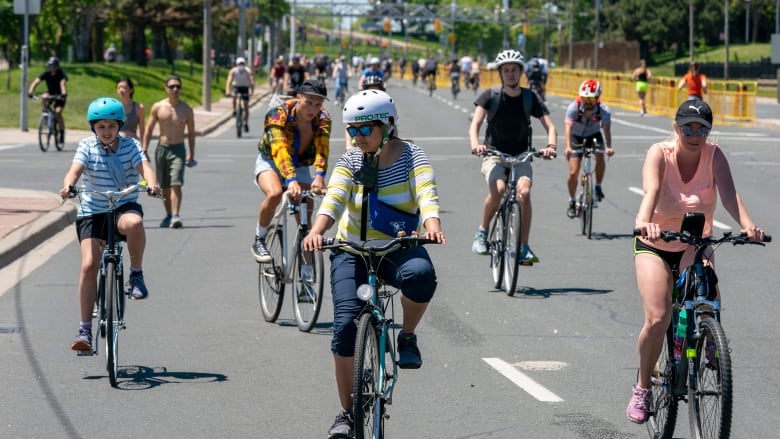Torontonians support bike lanes, want to see more protections, new poll suggests
66% of respondents want ActiveTO expanded, while 21% want program reduced, survey finds

The vast majority of Torontonians who responded to a new poll feel the city needs to do more to protect vulnerable road users and support the construction of protected bike lanes.
The poll, which was conducted by Ekos Research for the non-profit environmental group The David Suzuki Foundation, found that 84 per cent of respondents supported the construction of protected bike lanes in Toronto.
The poll also found that 85 per cent of respondents agreed the cityneeds to do more to protect vulnerable road users, includingpeople who are walking, seniors, kids, and people on bikes.
"What's exciting about this poll is the support is growing," said Gideon Forman, climate change and transportation policy analystwith The David Suzuki Foundation.
"I think it says that people realize we need to makestreets safer, that they want alternatives to the private automobile."
Ekos says the survey was conducted from Aug. 31 to Sept. 8, and included a random sample of 814 Toronto residents age 18 or older who responded online. Its total margin of error was +/- 3.4 percentage points, 19 times out of 20.
Interest in cycling surges
Streets filled with cyclists and pedestrians instead of cars have become a common sight in Toronto during the COVID-19 pandemic. With many people looking to find an alternative to public transit, even finding a new bike to purchase became difficult in many of the city's shops because stock was so scarce.
This spring, the city began swiftly installing approximately 40 kilometres of new bike lanes and bringing in temporary road closures including in high-traffic areas such as Dundas Street East, Bloor Street and University Avenue as part of its ActiveTO program.
Thenew infrastructure is technically only temporary and is due to be reviewed by city council sometime in 2021.
The foundation's poll also touched on ActiveTO, and asked respondents if they would like to see it expanded or cut back.
Sixty-six per cent said they would like to see the program expanded, while 21 per cent said they would like to see it cut back. Another 13 per cent of respondents said they didn't know, or had no response.
Michael Longfield, interim executive director of Cycle Toronto, told CBC Newshe hopes municipal leaders will look at the results of the poll and see a city hungry for better cycling infrastructure.
"The city can be bold. We've built more bike lanes this year than we have in any other year, and public support will only go up," he said.
"This isn't a time to be timid."
Not everyone convinced
Some opponents say the city's new bike lanes were rushed and should not be made permanent.
"Taking two lanes of traffic out of University Avenue will be a disaster when we get back to normal," Deputy Mayor Denzil Minnan-Wong said last month.
Coun. Stephen Holyday, who voted against the ActiveTO program in May, said in August that he also doubted the program's long-term viability.
"I think a number of advocates for these types of changes used the COVID situation to their advantage to advance something at a far quicker speed than we're used to in Toronto," said Holyday, who represents Ward 2,Etobicoke Centre.
But Longfield said he hopesdecision makers see that support for protected bike lanes in Toronto is strong and rising, especially as people look for modes of transportation that allow for physical distancing duringthe ongoing pandemic.
"Definitely, even before the pandemic there was already a lot of strong support for protective bike lanes," he said.
"If anything, the pandemic has just reemphasized that and made it important to even more people."
With files from Nick Boisvert












_(720p).jpg)


 OFFICIAL HD MUSIC VIDEO.jpg)
.jpg)



























































































